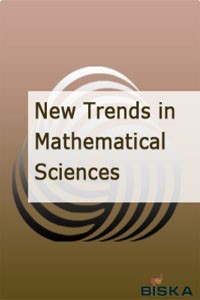Some bounds on local connective Chromatic number
Some bounds on local connective Chromatic number
___
- A. Dandashi and M.Al-Mouhamed, Graph coloring for class scheduling, In Proceedings of IEEE/ACS International Conference on Computer Systems and Applications (AICCSA), 1–4, 2010.
- A. Vasilyev, R. Darda and D. Stevanovi, Trees of Given Order and Independence Number with Minimal First Zagreb Index, MATCH Communications in Mathematical and in Computer Chemistry, 72, 775–782, 2014.
- A. William and S. Roy, Packing Chromatic Number of Cycle Related Graphs, International Journal of Mathematics and Soft Computing, 4, 27–33, 2014.
- B. Breˇsar, S. Klavˇzar, and D.F. Rall, On the packing chromatic number of Cartesian products, hexagonal lattice, and trees, Discrete Appl. Math. 155, 2303–2311, 2007.
- C.N. Lai, Optimal construction of all shortest node-disjoint paths in hypercubes with applications, IEEE Transactions on parallel and Distributed Systems, 23, 1129–1134, 2012.
- F. Iqbal and F. A. Kuipers, Disjoint Paths in Networks,Wiley Encyclopedia of Electrical and Electronics Engineering,Wiley, 2015.
- G. Chartrand, L. Lesniak, and P. Zhang. Graphs & Digraphs, Fifth edition, Taylor & Francis, 2010.
- K. Menger, Zur allgemeinen Kurventheorie, Fundementa Mathematicae, 10, 96–115, 1927.
- J.Topp and L.Volkmann, Sufficient conditions for equality of connectivity and minimum degree of a graph, Journal of Graph Theory 17, 695–700, 1993.
- M. Klesc and S. Schrotter, On the packing chromatic number of semiregular polyhedra, Acta Electrotechnica et Informatica, 12, 27–31, 2012.
- P.M.Talav´an and J.Y´a˜nez, The graph coloring problem: A neuronal network approach, European Journal of Operational Research, 191(1), 100–111, 2008.
- R. Qu, E.K. Burke and B. McCollum, Adaptive automated construction of hybrid heuristics for exam timetabling and graph colouring problems, European Journal of Operational Research, 198(2), 392–404, 2009.
- T. Park and C.Y. Lee, Application of the graph coloring algorithm to the frequency assignment problem, Journal of the Operations Research society of Japan, 39(2), 258–265, 1996.
- W. Goddard, S. M. Hedetniemi, S. T. Hedetniemi, J. M. Harris and D. F. Rall, Broadcast chromatic numbers of graphs, Ars Combinatoria, 86,33–50, 2008.
- ISSN: 2147-5520
- Başlangıç: 2015
- Yayıncı: Biska Bilişim
Holder valuation and holder rigidity for right ring of fractions
Abdolghafoor ALLAHYARİ, Mohammad Hossein HOSSEİNİ
Invariant criteria for the zero-coupon bond pricing Vasicek and Cox-Ingersoll-Ross Models
Ahmet BAKKALOGLU, Taha AZİZ, F. M. MAHOMED
Convergence of powers and Canonical form of s-transitive intuitionistic fuzzy matrix
Riyaz Ahmad Padder, P. MURUGADAS
Sanjib Kumar DATTA, Tanmay BİSWAS
Sanjib Kumar DATTA, Tanmay BİSWAS
Sanjib Kumar Datta, Tanmay Biswas, Ahsanul HOQUE
Some bounds on local connective Chromatic number
An order UV obtained by uninorm and nullnorm
The left Rieaman-Liouville fractional Hermite-Hadamard type inequalities for quasi-convex functions
